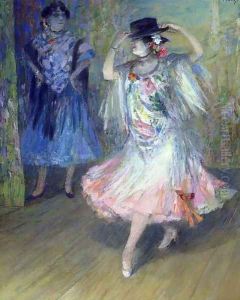Juan Roig y Soler Paintings
Juan Roig y Soler was a notable Spanish painter, born in 1852 in Barcelona, Catalonia. He emerged from a cultural backdrop rich in artistic tradition, during a period when the arts in Spain were undergoing significant transformation. His contributions were primarily in the realms of genre painting, landscapes, and portraits, reflecting the eclectic tastes of the late 19th century. Roig y Soler's style was deeply influenced by the Barbizon school and the burgeoning Impressionist movement, although he maintained a distinctive approach that blended traditional Spanish elements with more contemporary European trends.
After receiving his initial training at the Escuela de la Lonja in Barcelona, where he was influenced by the Catalan Renaixença—a cultural and political movement aimed at revitalizing Catalan identity—he continued his studies in Rome. This period was crucial for expanding his artistic horizons and integrating Italian influences into his work. Throughout his career, Roig y Soler exhibited a keen interest in capturing the ephemeral qualities of light and atmosphere, a characteristic that linked him with the Impressionist painters, though he never fully embraced the movement's more radical aspects.
His works were well received in both national and international exhibitions, contributing to his reputation as one of the leading Catalan painters of his time. Notably, Roig y Soler participated in the Exposición Nacional de Bellas Artes in Madrid and the Universal Exposition in Barcelona, where his art received significant recognition. His paintings are characterized by their vibrant color palette, delicate brushwork, and the ability to evoke the mood and character of his subjects.
Juan Roig y Soler's legacy is preserved in various museums and collections throughout Spain, including the Museu Nacional d'Art de Catalunya in Barcelona. His death in 1909 marked the end of an era for Catalan painting, but his influence persisted, inspiring future generations of artists in Catalonia and beyond. Through his works, Roig y Soler contributed to the narrative of Spanish art, bridging the gap between the romantic traditions of the 19th century and the modernist innovations that would define the early 20th century.
